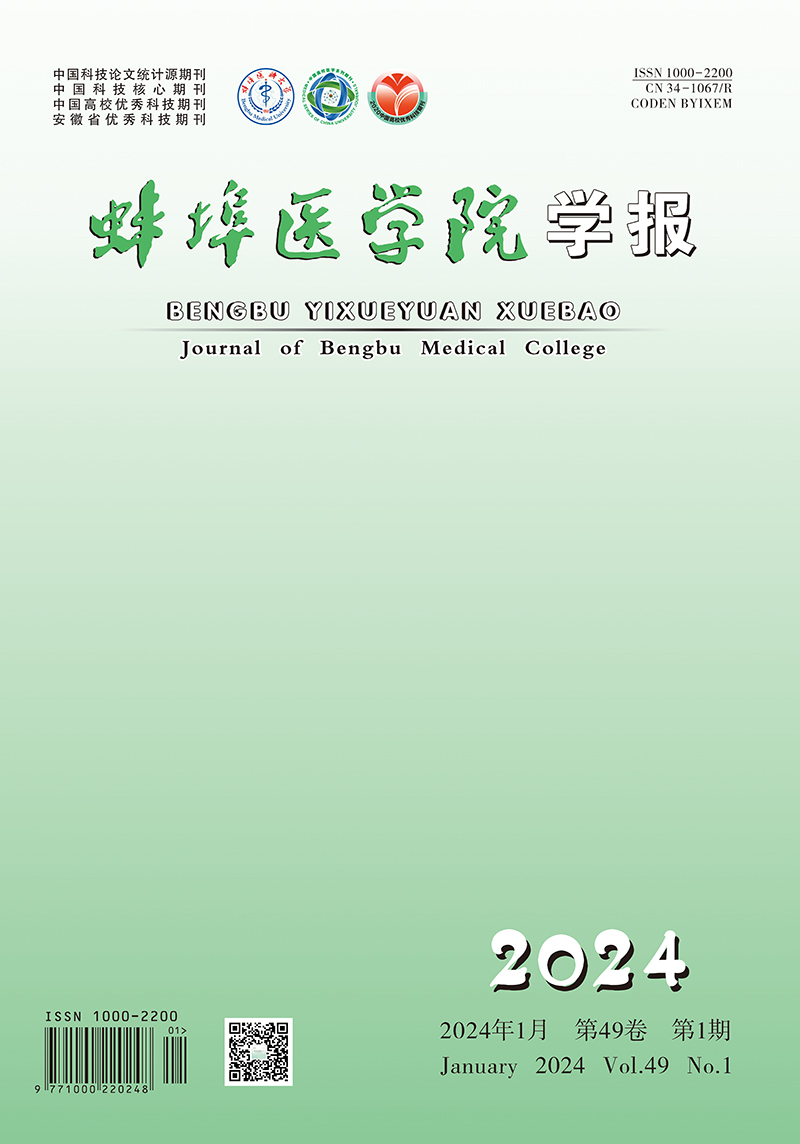-
骨肉瘤为原发性恶性骨肿瘤,多发于儿童与青少年人群,以疼痛、肿胀、病理性骨折为主要临床表现,由于其恶性程度高,侵袭性强,预后较差,病人术后5年生存率为65%~75%,骨肉瘤易发生转移,以肺转移为常见,发生转移病人的5年生存率仅为20%,目前关于骨肉瘤的发病机制尚不十分清楚[1-2]。鞘氨醇激酶1(sphingosine kinase 1, SPK1)是鞘脂代谢平衡的重要限速酶,可催化神经酰胺磷酸化形成1-磷酸鞘氨醇(sphingosine-1-phosphate, S1P),SPK1具有癌基因特性,在肿瘤中高表达,并促进肿瘤恶性转化[3]。吕冰洁等[4]研究表明,SPK1在小鼠肺癌细胞中高表达,抑制SPK1表达可通过Bcl-2/Bax途径干扰肺癌细胞凋亡。SPK1与S1P形成SPK1/S1P通路,在调控肿瘤细胞增殖、凋亡、迁移及耐药性等过程中发挥重要作用[5]。目前SPK1、S1P在骨肉瘤组织中的研究尚未见报道。本研究通过检测骨肉瘤组织中SPK1与S1P的表达情况,探讨其与骨肉瘤发生发展的相关性。
HTML
-
选择2016年7月至2018年8月我院收治的73例骨肉瘤病人作为研究对象,手术取骨肉瘤组织,所选病人中男45例,女28例,年龄7~45岁。73例病人中,肿瘤直径<5 cm者31例,≥5 cm者43例;发病部位为肢体55例,躯干部18例;骨母细胞型35例,软骨母细胞型18例,纤维骨母细胞型20例;Eneeking分期Ⅰ期者29例,Ⅱ~Ⅲ期44例;有肺转移者33例,无肺移者40例。纳入标准:(1)经病理学检查确诊为骨肉瘤;(2)术前未行靶向治疗、放化疗或免疫治疗;(3)病人临床资料完整。排除合并其他恶性肿瘤病人。
选择同期医院进行手术的骨软骨瘤手术切除标本31例作为对照,其中男18例,女13例,年龄8~46岁。本研究样本采集均经过本院伦理委员会批准。
-
SP免疫组化试剂盒及配套试剂、辣根过氧化物酶(horse radish peroxidase,HRP)标记山羊抗兔IgG购自北京索莱宝科技有限公司,兔抗人SPK1、S1P多克隆抗体购自Abcam公司。
-
手术过程中取得的骨肉瘤组织与软骨瘤组织标本石蜡包埋,连续切片(约4 μm厚)后,使用二甲苯脱蜡,浸入EDTA溶液中微波抗原修复10 min,去离子水洗涤,使用3% H2O2溶液以灭活内源性过氧化物酶,加入兔抗人SPK1(1∶800)、S1P(1∶1 000)多克隆抗体,4 ℃冰箱孵育过夜后,PBS洗涤,加入HRP标记的IgG(按1∶1 000稀释),室温孵育1 h,PBS洗涤,DAB染色,苏木素复染,梯度乙醇脱水,中性树胶封片,用已知阳性骨肉瘤组织切片做阳性对照,PBS为一抗作为阴性对照,显微镜观察。
染色结果判断:SPK1、S1P阳性表现为棕色或黄色颗粒,主要定位于细胞质或细胞膜。
评分=染色强度评分×阳性细胞比例评分,阴性(-)0分,弱阳性1~4分,记为(+),阳性为5~8分,记为2+,强阳性为9~12分,记为3+。细胞染色强度评分:无着色评0分、淡黄色评1分,棕黄色评2分,棕褐色评3分;阳性细胞比例评分:阳性细胞比例为0~5%、6%~25%、26%~50%、51%~75%、>75%,分别评分为0、1、2、3、4分。
-
采用χ2检验和Kaplan-Meier生存曲线。
1.1. 一般资料
1.2. 主要试剂
1.3. 免疫组织化学染色
1.4. 统计学方法
-
免疫组织化学染色结果显示,SPK1、S1P主要定位于细胞膜或细胞质,骨肉瘤组织SPK1阳性表达率为68.49%,高于软骨瘤组织中阳性表达率16.13%;骨肉瘤组织S1P阳性表达率为58.90%,高于软骨瘤组织中阳性表达率22.58%,差异均有统计学意义(P<0.01)(见表 1、图 1、2)。
n - + 2+ 3+ 阳性 χ2 P SPK1 软骨瘤组织
骨肉瘤组织31
7326
235
150
240
115(16.13)
50(68.49)23.95 <0.01 S1P 软骨瘤组织
骨肉瘤组织31
7324
306
131
180
127(22.58)
43(58.90)11.50 <0.01 -
根据SPK1、S1P在骨肉瘤组织中表达阳性结果,将骨肉瘤病人分为SPK1阳性表达组50例和S1P阴性表达组23例,S1P阳性表达组43例和S1P阴性表达组30例。分析发现, SPK1、S1P在Eneeking分期为Ⅱ~Ⅲ期和肺转移的病人中阳性表达率较高,差异均有统计学意义(P<0.05~P<0.01);SPK1、S1P在病人不同性别、年龄、肿瘤直径、发病部位、病理类型的阳性表达率差异无统计学意义(P>0.05)(见表 2)。
临床病理特征 n SPK1 χ2 P S1P χ2 P 阳性(n=50) 阴性(n=23) 阳性(n=50) 阴性(n=23) 性别 男
女45
2832(71.11)
18(64.29)13(28.89)
10(35.71)0.37 >0.05 24(53.33)
19(67.86)21(46.67)
9(32.14)1.50 >0.05 年龄/岁 <18
≥1858
1540(68.97)
10(66.67)18(31.03)
5(33.33)0.03 >0.05 36(62.07)
7(46.67)22(37.93)
8(53.33)1.17 >0.05 肿瘤直径/cm <5
≥532
4120(62.50)
30(73.17)12(37.50)
11(26.83)0.95 >0.05 21(65.63)
22(53.66)11(34.37)
19(46.34)1.06 >0.05 发病部位 肢体
躯干55
1837(67.27)
13(72.22)18(32.73)
5(27.28)0.15 >0.05 29(52.73)
14(77.78)26(47.27)
4(22.22)3.52 >0.05 病理类型 骨母细胞型 35 23(65.71) 12(34.29) 18(51.43) 17(48.57) 软骨母细胞型 18 12(66.67) 6(33.33) 0.55 >0.05 12(66.67) 6(33.33) 1.56 >0.05 纤维骨母细胞型 20 15(75.00) 5(25.00) 13(65.00) 7(35.00) Eneeking分期 Ⅰ
Ⅱ~Ⅲ29
4415(51.72)
35(79.55)14(48.28)
9(20.45)6.27 <0.05 11(37.93)
32(72.73)18(62.07)
12(27.27)8.74 <0.01 肺转移 是
否33
4024(84.85)
26(65.00)9(15.15)
14(35.00)7.47 <0.01 25(75.76)
18(45.00)8(24.24)
22(55.00)7.07 <0.01 -
73例病人全部完成随访,27例因死亡而终止随访,通过Kaplan-Meier生存曲线分析可知,SPK1阳性表达病人3年生存率为38.50%,SPK1阴性表达病人3年生存率为74.17%,SPK1阳性表达组3年生存率低于SPK1阴性表达组(χ2=5.63,P<0.05);S1P阳性表达病人3年生存率为34.06%,S1P阴性表达病人3年生存率为77.44%,S1P阳性表达组3年生存率低于S1P阴性表达组(χ2=8.95,P<0.05)(见图 3)。
2.1. 骨肉瘤组织与软骨瘤组织中SPK1及S1P表达水平比较
2.2. SPK1、S1P与骨肉瘤临床病理特征的关系
2.3. SPK1和S1P表达与骨肉瘤病人生存率关系的Kaplan-Meier生存分析
-
骨肉瘤是一种恶性程度及自残率极高的原发性肿瘤,其起病较为隐匿,早期发现比较困难,但进展快,多数病人确诊时已到中晚期,10%~20%的病人确诊时发生灶转移,导致病人预后较差,5年生存率较低,因此研究骨肉瘤的发病机制,对骨肉瘤的早期诊断及治疗具有重要临床意义[6-7]。
细胞内鞘磷脂代谢如SPK1、S1P与细胞增殖、凋亡密切相关,在肿瘤的发生中发挥重要作用,SPKl是一种具有广泛作用的细胞因子,对内皮细胞、软骨细胞、肿瘤细胞等多种细胞具有调节作用,与细胞的凋亡、增殖和迁移密切相关[8-9]。既往研究表明,SPK1在胃癌、结肠癌、鼻咽癌、肝癌、白血病等多种肿瘤中均有研究[10-11]。研究[12]显示,SPK1在骨肉瘤细胞中上调表达,与阿霉素耐药有关,敲低或过表达SPK1可改变阿霉素耐药性和细胞增殖活性。本研究结果显示,骨肉瘤组织SPK1阳性表达率显著高于软骨瘤组织中阳性表达率,提示SPK1可能与骨肉瘤的发生有关。通过分析SPK1与骨肉瘤临床病理特征相关性显示,SPK1在Eneeking分期为Ⅱ~Ⅲ期和肺转移的病人中阳性表达率较高,提示SPK1表达水平与骨肉瘤进展有关,与以往研究结果类似。蔡笃雄等[13]研究表明,胰腺癌中SPK1表达水平升高,SPK1的激活可促进胰腺癌细胞的增殖并抑制细胞的凋亡。推测SPK1可能通过促进骨肉瘤细胞增殖与转移,进而促进骨肉瘤的发生发展。进一步分析发现,SPK1阳性表达组3年生存率低于SPK1阴性表达组病人,提示SPK1可能与骨肉瘤病人生存情况有关,提示SPK1可能作为评估骨肉瘤病人预后的生物标志物。
SPK1是细胞内合成S1P的主要限速酶,S1P是一种抗凋亡基因,可促进细胞增殖,S1P与其受体S1PR结合,在调控肿瘤细胞的增殖、迁移等过程中发挥重要作用[14]。宋娟等[15]研究表明,乳腺癌细胞中S1P激活可通过调节STAT3信号通路促进乳腺癌细胞增殖。而抑制S1P及其受体信号通路,可抑制肺腺癌细胞的迁移与侵袭[16]。本研究结果显示,与软骨瘤组织比较,S1P在骨肉瘤组织中阳性表达率显著升高,提示S1P与骨肉瘤的发生发展过程有关。进一步分析结果显示,骨肉瘤组织中S1P表达水平与Eneeking分期和肺转移有关,提示S1P表达水平与骨肉瘤疾病进展有关。另外,本研究还显示,S1P阳性表达组3年生存率低于S1P阴性表达组,提示S1P阳性表达病人可能生存率较低,与病人预后相关。
综上所述,SPK1、S1P蛋白在骨肉瘤组织中高表达,且与骨肉瘤病人临床病理特征和预后有关,可能作为骨肉瘤病人潜在的预后标志物。但由于本研究临床样本数据少,可能存在一定偏倚,将扩大样本量作进一步研究。










 DownLoad:
DownLoad:

